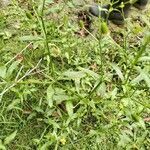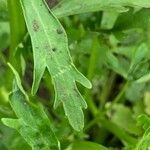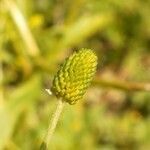Annual; roots all fibrous. Stems stout, erect, glabrous or with sparse appressed hairs, (10)-30-60-(75) cm tall. Basal and lower cauline lvs broadly ovate to reniform, cordate, deeply 3-(5)-lobed, glabrous or with fine appressed hairs, (1)-3-5-(8) × (1.5)-4-6-(10) cm; lobes obovate-cuneate, again shallowly 3-lobed and with crenate margins; petioles glabrous, (2)-5-10-(30) cm long. Upper cauline lvs similar; lobes becoming lanceolate, entire; uppermost lvs subsessile, not lobed, becoming finely appressed-hairy. Fls usually > 30 per stem, 6-10 mm diam. Pedicels erect, numerous, with sparse, fine hairs, sulcate, 2.5-4-(6) cm long at fruiting. Sepals 5, hairy, deflexed, acute, 3-4 mm long. Petals 5, pale yellow, broadly obovate, 3-4 × 2.5 mm; nectary single, 0.5 mm from petal base, pocket-like. Receptacle elongated, cylindric, hairy. Achenes (100)-200-400-(700), in cylindric heads, glabrous, hardly flattened, weakly keeled, obovoid, weakly rugulose; body c. 1 × 0.8 mm; beak < 0.5 mm long.
Stems erect, 2–6 dm, stout, hollow, glabrous, branched above and many-fld; basal and lower cauline lvs reniform, deeply 3-parted, the segments again cleft or lobed; upper lvs much smaller, commonly of 3 linear-oblong segments; pet 2–3 mm, shorter than the sep; achenes very numerous in a short-cylindric head, turgid, 0.8–1.2 mm, marginless, and very nearly beakless; 2n=32. Marshes, ditchbanks, and swampy meadows; circumboreal, in Amer. s. to Va., Mo., N.M., and Calif. Apr.–Aug. Our common phase, with minute, irregular transverse ridges on the central part of each face of the achene, is the widespread var. sceleratus. The chiefly western Amer. var. multifidus Nutt., with the basal lvs usually deeply twice cleft, and with the achene-surfaces smooth except for a circle of minute pin-prick depressions on each face, extends e. to Minn. and Io.
Stems erect, glabrous, rooting at base, only very rarely rooting at proximal nodes. Leaves basal and cauline, basal and proximal cauline leaf blades reniform to semicircular in outline, 3-lobed or-parted, 1-5 × 1.6-6.8 cm, base truncate to cordate, segments usually again lobed or parted, sometimes undivided, margins crenate or crenate-lobulate, apex rounded or occasionally obtuse. Flowers: receptacle pubescent or glabrous; sepals 3-5, reflexed from or near base, 2-5 × 1-3 mm, glabrous or sparsely hirsute; petals 3-5, 2-5 × 1-3 mm; nectary on petal surface, scale poorly developed and forming crescent-shaped or circular ridge surrounding but not covering nectary; style absent. Heads of achenes ellipsoid or cylindric heads, 5-13 × 3-7 mm; achenes 1-1.2 × 0.8-1 mm, glabrous; beak deltate, usually straight, 0.1 mm.
An annual herb. It is 20-70 cm high. The leaves vary in shape. The leaves near the base are stalked. They are 1.5-3 cm long by 2.5-4 cm wide. They are kidney shaped and with 3 lobes. The upper leaves are narrowly sword shaped with 3 lobes. The flowers are yellow. The fruit is dry, one seeded and in an oblong head.
Pending.













